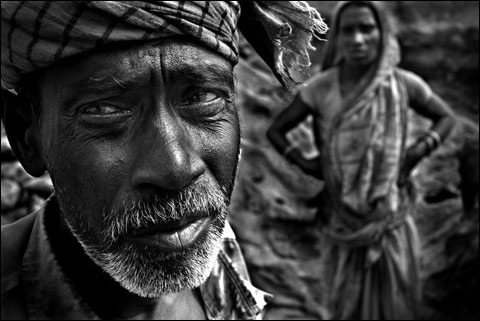
NO WORDS NEEDED: Khaled Hassan’s photos of Bangladeshi stone laborers hark back to a classic era of documentary photography. |
Listen carefully: is the Photographic Resource Center at Boston University throwing down the gauntlet? "I'm interested in bringing more documentary into the PRC," says Glenn Ruga, who became executive director in February.
That might not sound like a battle cry, but in a quiet way it is, since documentary photography, which dominated art photography with the likes of Dorothea Lange, W. Eugene Smith, and Robert Frank between the 1930s and the '60s, is nearly absent from the art world these days. What rules instead? Hollywood-ish posed fantasies (Cindy Sherman, Gregory Crewdson, and, locally, Triiibe and Caleb Cole). Snapshot slice-of-your-gang's-life (Nan Goldin, Ryan McGinley). And, especially, deadpan posed portraiture and architectural photography (Thomas Struth, Alec Soth, and, locally, Laura McPhee and Clare Beckett).
The pivot between documentary and deadpan occurred between Robert Frank's 1959 gritty street-photography odyssey book The Americans and the 1975 exhibit at George Eastman House in Rochester, "New Topographics: Photographs of a Man-Altered Landscape," which surveyed artists pursuing cool, "objective" landscape photography. The most influential artists in the show were Bernd and Hilla Becher of Germany, who photographed water towers, houses, and grain elevators as if collecting specimens. Many photographers also applied this detached anthropological style to posed portraits of persons with purposely blank, deadpan expressions. To distinguish themselves from Flickr, deadpan photographers resort to retro medium- and large-format-film cameras with larger negatives; these yield much richer colors and details, but their cumbersome size dictates a slower, more static, more wallflower approach than fleet-footed, in-the-middle-of-things documentary.
This stylistic change corresponds to a shifting photography market. Life (which began publication in 1936) and other picture news magazines offered a way of making a living at documentary photography. Today's photo market centers on fashion and celebrity (or corporate) portraits, so is it any surprise that fashion's deadpan models and elaborate stagecraft suffuse art photography? And note the influence of Yale, that finishing school for the New York art scene, which has taken up deadpan as a house style.
Deadpan is prominent in Boston, particularly at MassArt, where Nicholas Nixon, who was included in "New Topographics," teaches. But New England also has a tradition of experimental formalist photography that includes György Kepes, Minor White, Harry Callahan, and Aaron Siskind. In recent years, the PRC itself was on the cutting edge of photographic formalism — from photos charting the movement of stars to graph-like images of the major colors in compositions — under curator Leslie K. Brown, who left last summer to pursue doctoral studies at BU.
Ruga, who founded SocialDocumentary.net, a Web site devoted to documentary photography, in 2008, is thinking "less formalist" and more documentary for the PRC. "I describe it as more-academic work, and more popularly accessible work, but by people who are grounded in the tradition of fine-art photography."